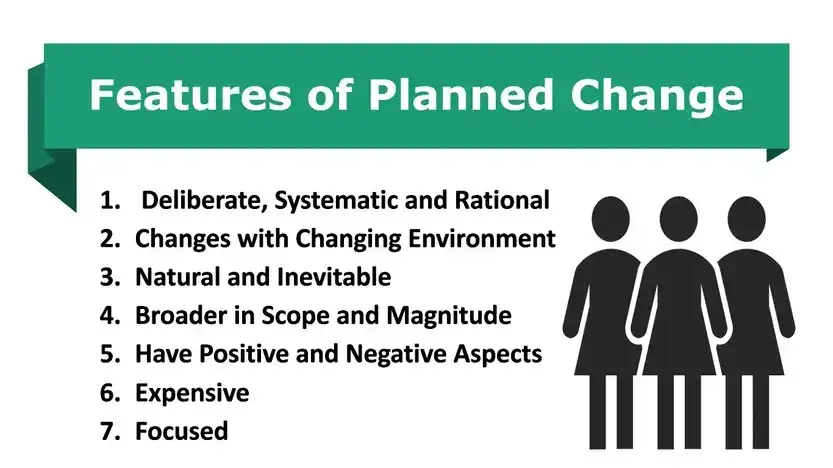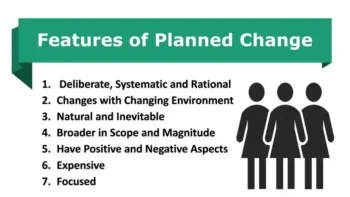Table of Contents:-
- Planned Change Meaning
- What is planned change?
- Planned Change Definition
- Features of Planned Change
- Steps for Managing Planned Change
Planned Change Meaning
Under a planned approach to change, change is ‘top-down’ in nature and refers to the sequential process of systematically planning, organising, and implementing change so that an organization can move from its current state to a desired future state (i.e, realising its vision) in a short period. Hayes observes that planned changes in organisations are usually triggered by the failure of people to create continuously adaptive organisations.
What is planned change?
Thus, planned changes are designed to change the behavioural elements of an organisation, such as people, processes and organisational culture, and ultimately lead to improved organisational outcomes. In the planned approach, change is initiated internally within the organisation in response to environmental pressures and the change usually affects many different parts of the organisation. Further, the top management of the organisation is not only responsible for initiating the change but also for its main planning and implementation. Burnes adds that implementation under the planned model of change depends on detailed plans and projections as well as the role of managers.
Planned Change Definition
According to Warren Bennis, “Planned change encompasses the application of systematic and appropriate knowledge to human affairs to create intelligent action and choices”.
According to Lippit, Watson, and Westley, “Planned change is a purposeful decision to effect improvements in a personality system or a social system that is achieved with the help of professional guidance”.
Features of Planned Change
Planned change has the following features:

1) Deliberate, Systematic and Rational: It is always deliberate, systematic and rational. These changes are the result of innovative and creative thinking on the part of the manager.
2) Changes with Changing Environment: It aims at coping with a changing environment and achieving a new set of goals for the organisation. These changes may arise both from internal as well as external environments. For example, if the organisation grows, planned changes are made to keep it in the right direction and to maintain continuity. Similarly, if there is a change in the competition, the manager has to develop a suitable course of action to deal with it effectively.
3) Natural and Inevitable: It is natural and inevitable. An organisation faces this problem regardless of its size. Every organisation makes some structural changes in response to the changing environment.
4) Broader in Scope and Magnitude: It is broader in scope and magnitude. They may affect the whole organisation or a substantial part of it in a significant way. Thus these changes aim at preparing the entire organization to adapt to change.
5) Have Positive and Negative Aspects: Planned changes may have both positive as well as negative aspects. If they have a positive aspect, they are more readily accepted by the employees; otherwise, the employees may resist the changes.
6) Expensive: Planned changes are difficult, expensive and painful. Due to these changes, employees may be compelled to surrender their comfortable and convenient work habits. Similarly, some local employees may lose their jobs.
7) Focussed: It may focus on the structure, processes, technology, people and organisational goals, depending on the nature and magnitude of change.
Steps for Managing Planned Change
Managing planned change requires a sustained commitment of resources to the change implementation process. Various steps involved in managing planned changes are as follows:
1) Engage in debate or dialogue about the need for change and the nature of the proposed solution.
2) Communicate consensus or decisions to all stakeholders.
3) Form a coalition to manage the change process.
4) Develop a work plan and ways to measure progress (metrics).
5) Implement the proposed change by integrating it into organisational culture, structure, and strategy.
6) Listen and learn, adjusting the nature of the solution and the speed of the process as needed.
You May Also Like:-
Nature of Organisational Behaviour
Conceptual Foundation of Organisational Behaviour
Contributing Disciplines to organisational behaviour
Models of Organisational Behaviour
Approaches of Organisational Behaviour
Emotional Intelligence in Organisational behaviour
Factors Influencing Perception
Scope of Organisational Behaviour
Importance of Organisational Behaviour
Challenges and Opportunities of Organisational Behaviour
Factors affecting group behaviour
Causes of Conflict in an Organisation
Types of Conflict in an Organisation
Organisational Development Process
Factors Affecting Organisational Culture
Trait Theory: Stogdill’s trait factors
Transactional Analysis in organisational behaviour
Techniques of Organisational Development
